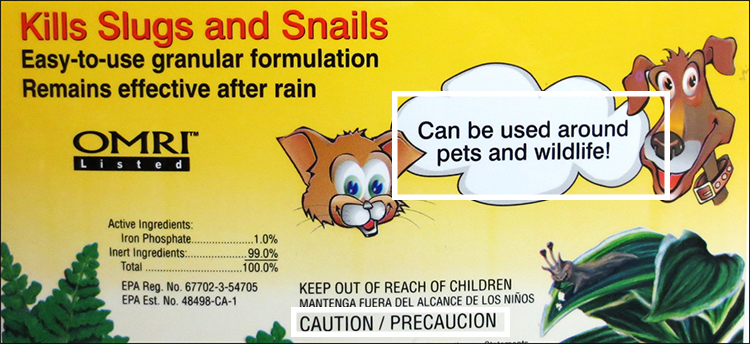UNDERSTANDING PESTICIDE LABELS TO PROTECT CHILDREN & pETS
The photo shows a family playing on a lawn. Children and pets can be exposed to pesticides used on the lawn or tracked indoors. The chemicals in pesticides can harm children and pets if they are exposed to them.
What are pesticides?
Pesticides are products designed to kill rodents, weeds, mosses, insects, plant diseases, slugs, and snails. Household disinfectants such as bleach and ammonia are considered pesticides. Flea-killer products are too.
JUMP TO
- Understand Pesticide Label Signal Words
- Choose Products Displaying the Signal Word “CAUTION”
- Avoid Exposing Children, Pregnant Women, and Elderly People to Pesticides
- Concerned about Pesticides Being Applied Nearby?
FOR QUESTIONS ABOUT PESTICIDES
The National Pesticide Information Center (NPIC) can answer questions about pest control chemicals.
1-800-858-7378 or npic@ace.orst.edu
Overview
Children, pregnant women, and elderly people are more sensitive to pesticides than healthy adults.
These groups have a higher risk of harm, including the following:
- Children exposed to pesticides early in life may experience atypical changes. Changes include physical development, behavior, and learning ability due to the exposure.
- Some pesticides can have an impact on our endocrine system and fertility.
- Elderly people possess a number of risk factors. These include thinner skin and slower toxin metabolism. Other health conditions may also interact negatively with pesticides in the bodies of elderly individuals. Medications may interact negatively with pesticides in the body.
Keys for Success
- Read pesticide labels. Follow the instructions.
- Use information provided on pesticide labels to understand the risks of a product and how to apply it.
- Follow the instructions to minimize risks. Follow the instructions to maximize benefits.
- Store pesticides in a secure area away from children and pets. See How to Store Pesticides.
- Pesticide product labels display a signal word plainly on the front of the package in all CAPS.
- The signal word describes the toxicity of the product.
| DANGER | This label statement means “high toxicity.” A small amount can be harmful. |
| WARNING | This label statement signifies “moderate toxicity.” A moderate amount can be harmful. |
| CAUTION | This label statement identifies “low toxicity.” A larger amount could be harmful. |
Pesticide signal word “CAUTION&rdqho;
- Pesticide products that display the signal word CAUTION contain the lowest risk to people and pets.
- The signal word CAUTION means the product is mildly irritating to the skin and eyes.
- Products with the signal word CAUTION are low in toxicity to people and pets when eaten or inhaled or exposed to skin.
What if a pesticide product doesn’t have a signal word?
- If the label doesn’t present a signal word, the product offers minimum risk. Such products are exempt from EPA pesticide signal word requirements.
- However, minimum risk is not risk-free. For example, pesticide products that include mint or thyme oil can damage your eyes on contact.
- Always read and follow the instructions on the product label.

- The white box on example pesticide product label highlights the signal word “CAUTION / PRECAUCIÓN.”
- The text in the other white box states “Can be used around pets and wildlife!”
- However, it is still vital to keep low toxicity pesticides away from children. The label also states, “KEEP OUT OF THE REACH OF CHILDREN / MATENGA FUERA DEL ALCANCE DE LOS NIÑOS.”
Pregnant women
- Focus on minimizing pesticide exposure to anyone who is pregnant. Allow as much time as possible between the pesticide application and when a pregnant individual is likely to enter the space.
Babies, toddlers & older children
- Don’t allow babies to touch pesticide-treated surfaces.
- Keep toddlers from playing on pesticide-treated surfaces or touching treated items. Wash their hands after playing outside near pesticide-treated areas. Don’t let them eat food in treated areas.
- Teach older kids to avoid chemical containers in or around the house.
- Plan pesticide applications to allow a period of time before people use the area. For example, give sprays time to dry thoroughly. For extra protection, plan for additional hours or days before kids return to the area.
Elderly people
- A pesticide product label includes important information for protecting everyone, including the elderly.
- However, elderly people should consider taking additional protective measures to minimize potential exposure.
- For example, take care handling clothing exposed to pesticides during laundry preparation.
- Consider washing your hands and face more frequently than the minimum requirement when handling a pesticide.
Consult a physician
- Consult a physician about any special precautions the person should take when using pesticides if you or your family members have health conditions.
Ask about precautions & get the EPA registration number
- If pesticides are being applied near you, ask the person applying the material what precautions you should take.
- If the person’s feedback is unclear, ask for the product’s EPA registration number, which is found on the product label.
Contact the National Pesticide Information Center.
- Then call 1-800-858-7378 or email npic@ace.orst.edu the National Pesticide Information Center(NPIC) .
- Share the EPA registration number and your concerns to understand the risks of your situation.
- Pesticide specialists can take the time to answer your questions and talk about strategies to reduce the risks.
Content provided by Kaci Buhl and Weston Miller.
Peer reviewed by OSU Department of Horticulture.
Pesticides & People References
Pesticides and Children
National Pesticide Information Center
Aging Populations
National Pesticide Information Center
Pesticides and Pregnancy
National Pesticide Information Center

